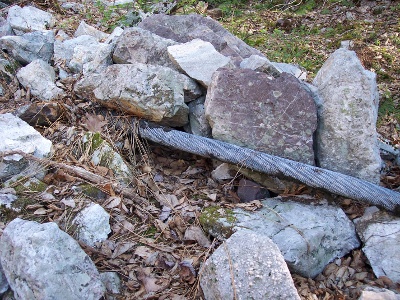Archive for April, 2010
Missing L3 Hut Found (demolished)
by balleman on Apr.11, 2010, under Technology
While hiking this weekend partly along the suspected area of the long-since-defunct Bedford-Harrisburg L3 cable, I found the apparent demolished remains of one of the repeater huts that had eluded me up to this point. As they all are, it was not far off the road, near the top of the mountain at Upper Strasburg. Guard rails have since been erected in front of what would have been it’s very small level parking area. Nearby there were also portions of exposed L3 cable that had apparently been covered in rocks instead of buried below grade. Really awesome, though unintentional, finds!
The map has been updated.

Demolished L3 Repeater Hut

Exposed L3 cable
Power vs. Energy
by balleman on Apr.08, 2010, under Science, Technology
I’m trying to catch up on some reading, and am working through a number of articles concerning energy sources, the power grid, and so forth. One almost constant source of annoyance I find in these articles is that the difference between power and energy are either ignored, misused, or left hopelessly ambiguous. The writers are not totally to blame, since our vocabulary for discussing these concepts is weak and it takes a lot of effort to clearly convey the correct meaning. Consider the following example:
The U.S. electric system has 2.5 gigawatts of pumped hydro storage capacity.
“Capacity” when used to discuss an energy storage apparatus can have two meanings. It could mean the power capacity of the system, which is the amount of energy that can be released from storage and converted to electricity instantaneously. For pumped hydro storage, this would be determined to a large degree by the size of the turbines, generators, and penstocks. This quantity represents, for instance, the number of lights a plant could handle without dimming – it says nothing about how long it could keep them lit. A common unit of power capacity is gigawatts.
The other type of “capacity” is the energy storage capacity of the system. For pumped hydro storage, this is the value related to the size of the water reservoir. This is the quantity that represents how long a plant could keep a given number of lights lit, for instance. A common unit of energy capacity is gigawatt-hours.
Assuming the author chose the units correctly, this quote tells us that the power capacity of US pumped hydro is 2.5 GW. Unfortunately, something isn’t right, because the Energy Information Administration says the number is actually 20 GW.
Consider another example:
The Norton project could store 2.7 gigawatts of power in an abandoned limestone mine.
I’m afraid this one is beyond redemption. You don’t store power, you store energy. But the units given are for power, and from further research in other articles, the power capacity of the plant is expected to be 2.7 gigawatts. I was not able to find a source that estimated the plant’s energy storage potential.
Any time you read the words “power,” “energy,” or “gigawatt” in an article, read it very critically. The commonly cited statistics for power plants are always their power capacity, and even for energy storage plants, storage capacity is seldom stated. One likely reason is that power capacity is relatively easy to determine – it is likely written on a nameplate on the generator somewhere. Calculating the energy capacity of a storage facility would be more challenging, and might not be a number required by regulators – and hence one that is seldom available.
Both quotes are from this wired.com article, but many articles discussing energy storage have the same problem.
TM-D710A Transmit Inhibit
by balleman on Apr.06, 2010, under Radio
I did recently get a TM-D710A and have been playing around with it. I have found one missing feature that would be nice, and a workaround for it. Suppose you want to add an amateur frequency as a memory channel for listening/scanning purposes only, but don’t want to ever accidentally transmit on that channel. I think it would make sense to have a flag that could be set on a per-channel basis to inhibit transmission on that channel, but unfortunately there is not. I have come up with a viable workaround though. It is possible to configure a memory channel as “split” – with a receive frequency and a separate transmit frequency. It is required that both frequencies be on the same band… though I’m not sure why – this would be a useful feature as well, so that one does not need to tie up both sides of the radio for half-duplex cross-band applications. Anyway, it is possible to configure the transmit frequency to be within the same band and still outside of the portion of the band which the radio can transmit on. This results in a beep and no transmission when PTT is pressed – which would be exactly the desired behavior of a transmit inhibit flag.